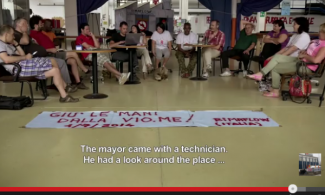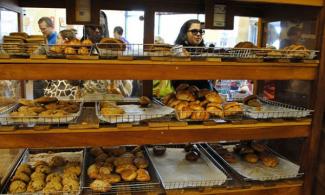GEO recently posted two pieces on the union-worker co-op model: one by John Clay of Democratic Promise and one by Jonathan Kissam of Web Skillet. For me both pieces raise what I consider to be the most crucial issue for the co-operative, solidarity, and all other democratic movements: the heartbreaking tendency for all democratic projects to put enormous hope in getting the structure for democratic participation right.
This issue is not the central focus of either piece. Rather, they touch on several aspects about the significance of this new model, especially how it promotes democracy. Jonathan’s piece focuses mostly on how the culture of the United Electrical Workers actively promotes democratic practice within his co-op: culture. John’s focus is mostly on how the structure of a union-co-op can promote greater democracy within a worker co-op, particularly a large one.
That model is exciting, and both pieces are really good. I highly recommend reading them.
However, my interest here is with the relationship between structure and culture within worker co-ops democratic projects in general. (I did a series of three blogs on this relationship in conversation with John McNamara of Union Cab of Madison Cooperative here, here, and here.) Both of the articles relate to this crucial dynamic: Kissam rather directly, Clay less so. But together they ring the issue loudly.
Here’s my basic take: there is an over-riding assumption that the right kind of democratic structure will produce a high level of high quality participation. I believe this is a faulty and unexamined belief. A lot of hope goes with it, but there is little factual support for it.
My conviction: high degrees of high quality participation come from a solid democratic structure embedded in a strong democratic culture.
Think of democracy as a garden: structures would be the plants and culture the soil. The soil will determine the quality of the plants more than the plants the quality of the soil. Plant democratic structures in conflicted soil and you get a mix that seriously lacks cooperation and collective power.
Culture is always both “out there” and “in here.” That is, we embody the cultures in which we have grown-up and which we navigate every day of our lives. It is right here inside each one of us. So we bring an extraordinarily complex combination of cooperative and oppressive beliefs, practices, ways of relating, norms, etc. into all of our relationships and projects. This is unavoidable. It is what we are. It is where we begin our co-operative and democratic projects.
The misleading faith in the power structure by itself stems from two factors. First, the failure to take into account the enormous and enduring influence of the prevailing culture on everything we think, feel, and do as individuals. It is by no means the only influence, but that particular influence, which I often call “karma,” can overwhelm any kind of new structure.
Second, it is far easier for us to think about structures than it is to think about how our received culture impacts the way we relate to each other and our democratic projects. How can fish know they are swimming in water. For them to function in the water, they have to take it for granted. For us to do our lives day-to-day we have to take so much for granted that we cannot give the mind space to being aware of its impact on us personally.
Yet, there is so much we have embodied—beliefs, habits, dispositions, values, etc.—from all the oppressive experiences of our lives. They are part of us and it is really difficult to see this, and when we do see it, it is really difficult to figure out what to do about it. And it is precisely these dynamics that sink or severely limit almost all of our efforts for democracy and just plain cooperation.
To make it even more difficult to identify and sort out what is going on with us is the fact that we are born cooperators. Empathy and cooperation are rooted in our biological being. There is also much in our cultures that works beautifully with basic yearnings for mutuality and aversion to oppression.
Clay and Kissam’s articles don’t fully take on this crucial issue of culture. Nor do our co-operative and solidarity movements, and other democratic movements. For example, at one point John asks a question:
If at the micro level cooperatives restore democracy through the governance structure of one worker, one vote, what are the mechanisms by which they would restore democracy at the macro level?
There are two issues in this passage that relate directly to what I am saying. One, appropriate micro-level governance structures are essential for democratic projects like worker co-ops, but they cannot in themselves achieve democracy. They must grow out of rich democratic soil, and that soil can only come from transformative tilling. That is, we have to become the change we want to bring to the world, transforming ourselves personally through learning how to develop small cooperative cultures, giving this profound need its due.
Second, to what does “restore democracy” refer to? I don’t think there ever was a golden age of democracy. Rather, democracy is, in the words of Raymond Williams, “a long revolution” that began some 350 years ago and will probably take at least another “seven generations” of evolution to fulfill.
So what do we do now? We begin where we are with what we are: pioneers in a slow evolutionary process. Ultimately, we have to learn how to transform ourselves so that we can learn how to create a new kind of culture. We need to visualize worker co-ops and other democratic projects as also being laboratories for researching and developing how to create cultures that can maximize our tendencies for mutuality and minimize those that drag us back into oppressive ways of relating.
Both John and Jonathan give us clues. I would like to touch on these here, but this piece is already too long. Also, in reading their pieces you will find those clues yourself. Thanks.




Add new comment